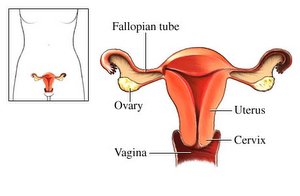It's common for women and girls to experience

It's common for women and girls to experience some discomfort in the days leading to their periods. Premenstrual syndrome (PMS) includes both physical and emotional symptoms that many girls and women get right before their periods, such as acne, bloating, fatigue, backaches, sore breasts, headaches, constipation, diarrhea, food cravings, depression, irritability, or difficulty concentrating or handling stress. PMS is usually at its worst during the 7 days before a girl's period starts and disappears once it begins.
Many girls also experience abdominal cramps during the first few days of their periods. They are caused by prostaglandin, a chemical in the body that makes the smooth muscle in the uterus contract. These involuntary contractions can be either dull or sharp and intense.
It can take up to 2 years from menarche for a girl's body to develop a regular menstrual cycle. During that time, her body is adjusting to the hormones puberty brings. On average, the monthly cycle for an adult woman is 28 days, but the range is from 23 to 35 days.
If a female and male have sex within several days of the female's ovulation (egg release), fertilization can occur. When the male ejaculates (which is when semen leaves a man's penis), between 0.05 and 0.2 fluid ounces (1.5 to 6.0 milliliters) of semen is deposited into the vagina. Between 75 and 900 million sperm are in this small amount of semen, and they "swim" up from the vagina through the cervix and uterus to meet the egg in the fallopian tube. It takes only one sperm to fertilize the egg.
About a week after the sperm fertilizes the egg, the fertilized egg (zygote) has become a multi-celled blastocyst (pronounced: blas-tuh-sist). A blastocyst is about the size of a pinhead, and it's a hollow ball of cells with fluid inside. The blastocyst burrows itself into the lining of the uterus, called the endometrium (pronounced: en-doh-mee-tree-um). The hormone estrogen causes the endometrium to become thick and rich with blood. Progesterone, another hormone released by the ovaries, keeps the endometrium thick with blood so that the blastocyst can attach to the uterus and absorb nutrients from it. This process is called implantation (pronounced: im-plan-tay-shun).
As cells from the blastocyst take in nourishment, another stage of development, the embryonic stage, begins. The inner cells form a flattened circular shape called the embryonic disk, which will develop into a baby. The outer cells become thin membranes that form around the baby. The cells multiply thousands of times and move to new positions to eventually become the embryo (pronounced: em-bree-o). After approximately 8 weeks, the embryo is about the size of an adult's thumb, but almost all of its parts - the brain and nerves, the heart and blood, the stomach and intestines, and the muscles and skin - have formed.
During the fetal stage, which lasts from 9 weeks after fertilization to birth, development continues as cells multiply, move, and change. The fetus (pronounced:



0 Comments:
Post a Comment
<< Home